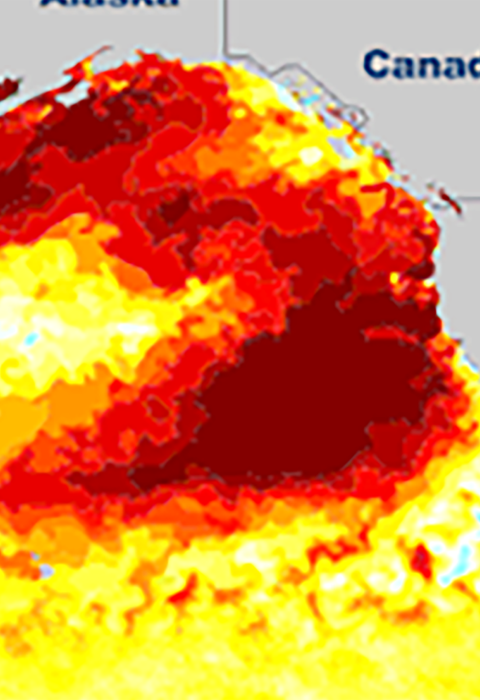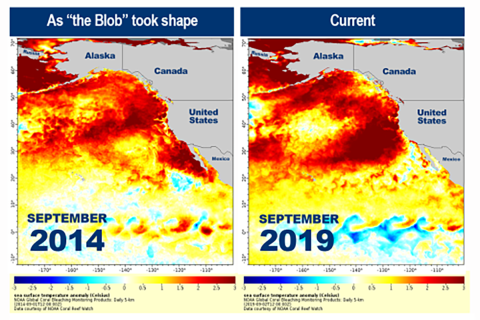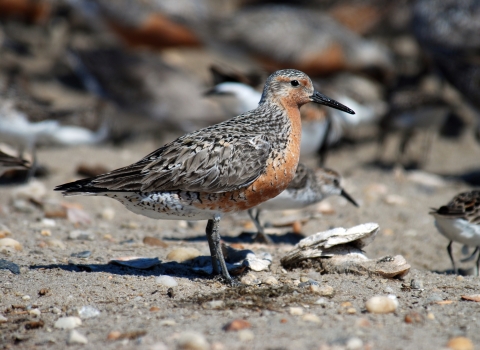The heat blob. It brings to mind the horror movie, “The Blob,” or a large wildfire seen from space. The heat blob evokes an image of a hot, angry, foaming bubble that slowly and methodically wrecks everything in its path.
Unfortunately, that’s exactly what it is.
The heat blob, or simply, “the blob” as the National Oceanic and Atmospheric Administration (NOAA) calls it, is a relatively new oceanic heat wave taking over the continental shelves around the North American and Asian continents. Scientists first observed a heat blob in 2014, when it disrupted marine ecosystems off of the West Coast of the United States, and depressed salmon returns. In 2019, the blob returned.
“There are serious disruptions to the food chain going on right now due to ocean warming and other changes,” U.S. Fish and Wildlife Service seabird coordinator Roberta Swift said. “These Pacific-wide changes affect seabirds throughout their entire Pacific Range. This could affect the quantity or quality food available for seabirds in the Pacific, meaning seabirds might skip breeding, abandon their nests, or die of starvation.”
The changes start at the bottom of the food chain, and disrupt predator-prey relationships all the way to the top. Here’s one example: Warmer water conditions encourage warm water zooplankton to proliferate in areas formerly dominated by cold-water species. Warm water zooplankton have a lower lipid (fat) content than cold-water plankton. For the fish that rely on the cold-water plankton, the warm water zooplankton simply are not as nutritious. The forage fish that eat the warm water zooplankton do not grow as big, which then results in fewer calories and less energy for their predators, including seabirds. That, in turn, can result in starvation and death.
In 2019, thousands of migratory short-tailed shearwaters died off the coast of Alaska. Shearwaters spend their summers (our winter) and breed in South America, and then fly up the coast during their winter (our summer). Because of their high metabolic rate, they rely on huge numbers of krill, small fish, or squid. If there are fewer numbers of these krill or fish, or they have a lower value nutritional content, it could lead to a significant die-off. In previous years, die-offs affected common murres, tufted puffins, and Cassin’s auklets, each in turn.
“Ocean warming events most affect colder oceans in this way,” Swift said. “Warming events can alter ocean circulation patterns and affect forage fish distributions which may require seabirds to fly farther for their meals, making feeding themselves and their young much more difficult and energy expensive.”
Another way that that human activities affect the marine food change is through input of carbon dioxide into the atmosphere. Excess carbon dioxide causes ocean acidification, which is the absorption of carbon dioxide into seawater. According to NOAA, a series of chemical reactions result in an increased concentration of hydrogen ions and a decrease in carbonate ions.
Carbonate ions are essential building blocks of calcium carbonate. Calcium carbonate is critical in the formation of the exoskeletons of crustaceans that make up the zooplankton, fundamental components of the oceanic food chain. Many seabirds eat the larval stages of fish and invertebrates, but shells and exoskeletons cannot develop normally in an acidified ocean with increasingly acidic conditions. We will all have less seafood to eat if larval crustaceans can’t develop into adults.
According to NOAA, shifts in the marine food web during the evolution of the 2014-2015 marine heatwave called, “the Blob,” forced sea lion mothers to forage further from their rookeries in the Channel Islands off Southern California. Hungry pups set out on their own, but many became stranded on area beaches. Picture courtesy of NOAA
Many communities around the world are dependent on shellfish and fish higher up the food chain for food and exports. These days, shellfish farmers must pay special attention to the acidity of the water that bathes larval oysters in order to ensure their development into the adult oysters we eat. The changes affecting tiny organisms in our oceans right now are leading to big changes for fish, birds, and people.
Although getting rid of heat blobs and ocean acidification might seem daunting, some of the little things you can do can help. Reduce your energy footprint. Recycle your waste. Try to be mindful of your consumption. Most of all, treat your oceans and your planet with respect. All the little things (and big things!) count.
Below are some more resources to learn about the blob and ocean warming.






